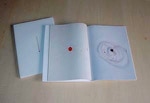In the proximity of ‘Complexity ’ Not Observation
Takami Akihiko, Art Critic
2002 Art Book [℃]
What is distinctive about curiosity, which children show to the word , is the way they recognize everything that moves as a living creature. Their attitude, when they play with toy robots and cars, is equivalent to that toward kitten or worms crawling on the floor. It might remind you of dwarves living inside a clock to move the hands.
You wonder when they tall a sleep after working all day long…This psychological action of personifying and identifying the world reveals the true nature of human beings, which live in many folklore and stories or animism(spiritualism) long survived among aborigines.
Every time I hear story of how Moroizumi came up with the idea of using thermometers as a medium, it reminds me of the original relationship between human and world, human and object, which is like the episode of dwarves and a clock. Primitive people felt the spirit in the trees and stones as they lived with nature. Their fear of the spirit made them personify things in the world. Modern people tend to become fetish to what is artificial or man-made, forgetting about nature .It is called animism in an expensive way. What is to be considered is the characteristic of <a meter> in the world full of cars, clothes, jewelry, cameras and such, worthy of a topic of psychoanalysis.
Clocks, magnets and some other meters can be categorized in a meter as well as a thermometer. They are the tools created to make things that are invisible to our eyes, like environment or energy, visible, and to make them measurable. Most of them are digitized today. On the other hand, analogue meters have the atmosphere that they live their own life as if they unite human being and the world, standing on the borderline of humans and the ever-changing world. Can you imagine that someone is traveling in the desert or the ocean with a compass or a barometer and he (she) dies by accident…the tool continues indicating directions and weather changes? When a thermometer responds to the changes in nature, it can be assumed that the thermometer gets the identity as ‘another kind’, which doesn’t belong to creatures nor to object and that identity continues existing even having taken away its functions or purpose of measuring.
Moroizumi was attracted to this when creating sculptures. A process in which a thermometer existed as a main element. At his early stage of works, he worked on sculptures of ‘tower’ using lead, iron, plaster and wax. He needed to use a thermometer in the working process of melting, welding, congealing and molding those materials.
A thermometer was just one of equipment in his atelier. However, as the red liquid was climbing up and down inside the glass tube, it became ‘a living tower’ to his eyes. It was an obvious comparison with the ‘tower’ which was created as a metaphor for constructing a civilization including the chance of deconstruction.
‘Revelation’ brought by a thermometer – the emergence of ‘a living sculpture’ which exists along with the changing environment and exists on the borderline, brought up the death of existing sculpture and the possibility of relating plasticity of civilization from the Tower of Babel to skyscrapers.
The first thing Moroizumi did to utilize a thermometer as a medium was to erase the scales. Then it escaped from being subordinating to human being as a measurement tool and proved its positioning of existence. It is said that the ‘thermo scope’ invented by Galileo Galilei in the early 17th century that a liquid type of ‘thermometer’ was invented.
One of Moroizumi’s early works is “Original”(1991). Thermometers were put up in the form of towers and blockaded on the flat panel. “℃, 4000=1”(1994) was 4000 thermometers joined side by side on the wall, so that one line reacted to the change of the room temperature. Another work of chained thermometers is called “℃+CF”(1996), in which thermometers were lined up on the disk to see the relationship among temperature, centrifugal force and gravity. “℃+M+T”(1996) shows the thermometers of human length set at a regular interval.
They reflect the real time disturbance by a man moving beside. Also it records the temperature change, using a thermo-hygrometer*, as time passes, then it develops the expansion of temperature into the air and time. Another work by a thermo-hygrometer* demonstrates the line of temperature wiping off the words and pictures printed on a paper.
“℃ with ∞”(1998) is a work using a liquid thermometer, which pours blue liquid into ∞ shape of a tube. Variations of size, style and color of thermometer is becoming more possible. However, in terms of expanding his options on his works, a liquid crystal is another challenge. If a liquid crystal is applied or coated directly to the surface of an object , it can be transformed into ‘a thermometer’. There are a series of his works, in which artificial or sunlight is beamed onto the object coated with liquid crystal , providing heat to it. In those works, the characteristics of light=heat(temperature) makes an invisible band of temperature visible, communing with world temperature that appears in a more way. Translation Ayumi Kudo

ⒸSHIGERU MOROIZUMI